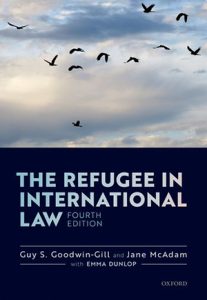The Refugee in International Law (Fourth Edition)

Author: Guy S. Goodwin-Gill and Jane McAdam, with Emma Dunlop
Publisher: Oxford University Press
Year of Publication: 2021 (Fourth Edition), 1983 (First Edition)
Print Length: 864 pages
Genre: Non-Fiction / Law, Migration & Refugee Studies
Area: Global, Mediterranean
The status of the refugee in international law, and of everyone entitled to protection, has ever been precarious, not least in times of heightened and heated debate: people have always moved in search of safety, and they always will. In this completely revised and updated edition, the authors cast new light on the refugee definition, the meaning of persecution, including with regard to gender and sexual orientation, and the protection due to refugees and those affected by statelessness or disasters. They review the fundamental principle of non-refoulement as a restraint on the conduct of States, even as States themselves seek new ways to prevent the arrival of those in search of refuge.
Related principles of protection—non-discrimination, due process, rescue at sea, and solutions— are analysed in light of the actual practice of States, UNHCR, and treaty-monitoring bodies. The authors closely examine relevant international standards, and the role of UNHCR, States, and civil society, in providing protection, contributing to the development of international refugee law, and promoting solutions. New chapters focus on the evolving rules on nationality, statelessness, and displacement due to disasters and climate change.
This expanded edition factors in the challenges posed by the movement of people across land and sea in search of refuge, and their interception, reception, and later treatment. The overall aim remains the same as in previous editions: to provide a sound basis for protection in international law, taking full account of State and community interests and recognizing the need to bridge gaps in the regime which now has 100 years of law and practice behind it.
Table of Contents
List of States
Tables of Cases
Table of Treaties and Other International and Regional Instruments
Selected Abbreviations
Note to the Reader
1. The Refugee in International Law
PART 1: REFUGEES
2. Refugees Defined and Described
3. Determination of Refugee Status: Analysis and Application
4. Loss and Denial of Refugee Status and Its Benefits
PART 2: ASYLUM
5. The Principle of Non-refoulement— Part 1
6. The Principle of Non-refoulement— Part 2
7. Protection under Human Rights and General International Law
8. The Concept of Asylum
PART 3: PROTECTION
9. International Protection
10. International Cooperation, Protection, and Solutions
11. Treaty Standards and their Implementation in National Law
12. Displacement related to the Impacts of Disasters and Climate Change
13. Nationality, Statelessness, and Protection
Select Bibliography
Index
Full Table of Contents
List of States
Tables of Cases
Table of Treaties and Other International and Regional Instruments
Selected Abbreviations
Note to the Reader
1. The Refugee in International Law
1.1. Introduction
1.2. The refugee in the law and practice of the United Nations Security Council
1.3. The refugee in national and international law
1.4. Protection
1.5. A future circumscribed, or free?
PART 1: REFUGEES
2. Refugees Defined and Described
2.1. Refugees
2.2. Refugees defined in international instruments 1922-46
2.3. Refugees for the purposes of the United Nations:
2.3.1. Statute of the United Nations High Commissioner for Refugees (UNHCR)
2.3.2. Development of the statutory definition and extension of the mandate
2.3.3. Internally displaced persons:
2.3.3.1. The problem in context
2.3.3.2. UN and UNHCR responsibilities
2.4. Refugees in the sense of the 1951 Convention and the 1967 Protocol relating to the Status of Refugees
2.5. Regional approaches to refugee definition
2.6. Refugees in municipal law: some examples
2.7. Institutional responsibilities and international obligations
2.8. ‘Refugees’ for the purposes of general international law
3. Determination of Refugee Status: Analysis and Application
3.1. Respective competence of UNHCR and of States parties to the Convention and Protocol
3.2. Determination of refugee status by UNHCR
3.3. Determination of refugee status by States
3.3.1. The European Union Qualification Directive
3.4. Persecution: Issues of interpretation
3.4.1. Protected interests
3.4.2. The ways and means of persecution
3.4.2.1. Persecution as a crime in international law
3.4.3. Agents of persecution
3.4.3.1. Agents of persecution and State responsibility
3.4.4. Fear, intent, motive, and the rationale for persecution
3.5. The refugee definition and the reasons for persecution
3.5.1. General matters
3.5.1.1. Good ‘faith’ and activities in the country of refuge
3.5.1.2. Nationality and statelessness
3.5.1.3. Deprivation of citizenship, persecution, and the country of one’s nationality
3.5.2. Reasons for persecution
3.5.2.1. Race
3.5.2.2. Religion
3.5.2.3. Nationality
3.5.2.4. Membership of a particular social group
3.5.2.4.1. The concept develops
3.5.2.4.2. The categories of association
3.5.2.4.3. Common victimization
3.5.2.4.4. Gender-based claims
3.5.2.4.5. Sexual orientation and gender identity claims
3.5.2.4.6. A social view of ‘social groups’
3.5.2.5. Political opinion
3.6. Persecution: issues of application
3.6.1. Persecution and laws of general application
3.6.1.1. Conscientious objectors
3.6.1.1.1. The right of conscientious objectors
3.6.1.1.2. The right to object to participation in conflict ‘condemned by the international community’
3.6.1.1.3. The nature of the dispute between the individual and the State
3.6.1.1.4. Establishing a well-founded fear of being persecuted
3.6.2. Persecution and situations of risk
3.6.2.1. International protection/flight/relocation alternative
3.6.2.2. Flight from armed conflict and violence
3.6.2.3. The individual and the group
3.6.3. Children as asylum seekers
3.7. Persecution and lack of protection
4. Loss and Denial of Refugee Status and Its Benefits
4.1. ‘Revocation’, cessation, and exclusion
4.2. Cessation: voluntary acts of individual
4.3. Cessation: change of circumstances
4.3.1. Personal circumstances
4.3.2. Change of circumstances in the country of origin
4.3.3. The cessation inquiry
4.3.4. Continuing status in exceptional circumstances
4.4. Protection or assistance by other States or United Nations agencies
4.4.1. The country of first asylum principle
4.4.2. Refugees receiving United Nations protection and assistance
4.4.2.1. Historical background
4.4.2.2. The UNHCR Statute and the 1951 Convention
4.4.2.3. Protection under the 1951 Convention
4.4.2.4. Subsequent developments
4.4.2.5. Looking ahead
4.4.3. Other refugees not considered to require international protection
4.5. Exclusion from refugee status
4.5.1. ‘[S]erious reasons for considering’
4.5.2. Crimes against peace, war crimes, and crimes against humanity
4.5.2.1. The drafting history of article 1F(a)
4.5.2.2. The scope of article 1F(a)
4.5.2.2.1. Crimes against peace
4.5.2.2.2. War crimes
4.5.2.2.3. Crimes against humanity
4.5.2.3. Individual responsibility
4.5.3. Serious non-political crimes
4.5.3.1. The drafting history of article 1F(b)
4.5.3.1.1. The relation to extradition
4.5.3.1.2. ‘Serious’ and ‘non-political’
4.5.4. Acts contrary to the purposes and principles of the United Nations
4.5.4.1. The drafting history of article 1F(c)
4.5.4.2. The ‘purposes and principles of the United Nations’
4.5.4.3. Individual responsibility
4.5.4.4. Refugee status, security, and terrorism
4.5.4.5. Terrorism, armed conflict, and the United Nations
PART 2: ASYLUM
5. The Principle of Non-refoulement— Part 1
5.1. Evolution of the principles
5.2. The principle of non-refoulement in general international law
5.2.1. Conventions and agreements
5.2.2. Declarations and solutions
5.2.3. The UNHCR Executive Committee Conclusions on International Protection
5.2.4. State views and State practice
5.2.4.1. State views
5.2.4.2. State practice: some aspects
5.3. The scope of the principle of non-refoulement in the 1951 Convention
5.3.1. Personal scope
5.3.2. The question of risk
5.4. Exceptions to the principle of non-refoulement in the 1951 Convention
5.5. Relationship of the principle of non-refoulement to other contexts
5.5.1. Non-refoulement and ‘illegal’ entry
5.5.2. Non-refoulement and extradition
5.5.3. Non-refoulement and expulsion
5.6. Non-refoulement in cases of mass influx
5.6.1. Some aspects of State practice
5.7. Temporary protection
5.7.1. The norm of temporary refuge
5.8. Non-refoulement through time
5.9. Non-refoulement as a principle of customary international law
6. The Principle of Non-refoulement— Part 2
6.1. Time and place, ways and means
6.1.1. Extraterritorial application
6.1.1.1. Establishing responsibility
6.1.1.2. Example: interception on the high seas
6.1.2. ‘International zones’
6.1.2.1. ‘Frontiers of territories’ and diplomatic asylum
6.1.3. Joint and several state responsibility
6.2. Non-refoulement and flight by sea
6.2.1. Stowaways
6.2.2. Asylum seekers at sea
6.2.2.1. High seas
6.2.2.2. The contiguous zone
6.2.2.3. Internal waters and the territorial sea
6.2.3. Rescue-at-sea
6.2.3.1. International cooperation and the case of the Mediterranean
7. Protection under Human Rights and General International Law
7.1. Introduction
7.2. The evolution of complementary forms of protection
7.3. The scope of protection under human rights law
7.3.1. Absolute nature of non-refoulement in human rights law
7.3.2. Torture
7.3.2.1. Lawful sanctions
7.3.2.2. Intent
7.3.3. Cruel, inhuman, or degrading treatment or punishment
7.3.4. General risk
7.3.5. Standard or proof
7.3.6. Right to life
7.3.6.1. Death penalty
7.3.7. Right to an effective remedy
7.4. Other rights
7.5. Best interests of the child
7.6. The European Union Qualification Directive
7.7. Rights and legal status for beneficiaries of complementary protection
7.7.1. Exclusion from complementary protection
8. The Concept of Asylum
8.1. Introduction
8.2. Asylum in international conventions, other instruments, and acts
8.3. Asylum in regional agreements
8.4. Obstructing asylum: trends in State practice
8.4.1. Access
8.4.2. Interception
8.4.3. Other non-arrival policies
8.4.3.1. Visa regimes
8.4.3.2. Pre-entry clearance and carrier sanctions
8.5. International law responses
8.5.1. The right to leave the country
8.5.2. Article 31 of the 1951 Convention
8.5.3. Good faith
8.6. Non-admission policies: the ‘safe’ country and the concept of ‘effective protection’
8.6.1. Jurisdictional issues: identifying the State responsible for determining a protection claim
8.6.2. The ‘safe country’ mechanism
8.6.3. ‘Effective protection’
8.6.4. Safe country practices in the European Union
8.6.4.1. First country of asylum
8.6.4.2. Safe country of origin
8.6.4.3. Safe third country
8.6.4.4. European safe country
8.6.4.5. Dublin Regulation
8.6.5. The US-Canada Safe Third Country Agreement
8.6.6. Readmission agreements
8.6.7. Extraterritorial processing
8.6.7.1. Legal concerns
8.7. Standards of treatment for asylum seekers
8.8. Detention
8.8.1. Detention and mass influx
8.9. Conclusion
PART 3: PROTECTION
9. International Protection
9.1. International institutions
9.1.1. The Office of the United Nations High Commissioner for Refugees (UNHCR)
9.1.1.1. Relation of UNHCR to the General Assembly and its standing in general international law
9.1.1.2. The UNHCR Executive Committee
9.1.2. The United Nations Relief and Works Agency for Palestine Refugees in the Near East (UNRWA)
9.1.3. The Office of the United Nations High Commissioner for Human Rights (OHCHR)
9.1.4. The United Nations Office for the Coordination of Humanitarian Affairs (OCHA)
9.1.4.1. Strengthening coordination
9.1.4.2. The complementary role of UN agencies
9.1.5. Other organizations and agencies
9.1.5.1. International Organization for Migration (IOM)
9.1.5.2. The International Red Cross and Red Crescent Movement
9.1.5.3. Regional organizations
9.1.5.4. Non-governmental organizations (NGOs)
9.1.5.5. Humanitarian workers
9.2. The protection of refugees in international law
9.2.1. General international law
9.2.2. Treaties and municipal law
9.2.2.1. The principle of good faith
9.3. The protection of particular groups of refugees
9.3.1. Women refugees
9.3.2. Child refugees
9.3.3. Refugees with disability
10. International Cooperation, Protection, and Solutions
10.1. Refugee rights in camps, in settlements, and at large
10.2. Solutions
10.2.1. Local integration
10.2.2. Voluntary repatriation
10.2.2.1. Facilitating and promoting
10.2.2.2. Safe return
10.2.3. Resettlement
10.2.4. Complementary pathways to admission
10.2.5. Assistance and development
10.3. International cooperation
10.3.1. The New York Declaration and the Global Compacts
10.3.1.1. Refugee Compact
10.3.1.2. Migration Compact
11. Treaty Standards and their Implementation in National Law
11.1. The 1951 Convention and the 1967 Protocol relating to the Status of Refugees
11.1.1. Equality of treatment, employment, and social benefits
11.1.2. Standards applicable to refugees as refugees
11.1.2.1. Administrative assistance: article 25
11.1.2.2. Identity documents: article 27
11.1.2.3. The Convention travel document: article 28
11.1.2.4. Treatment of refugees entering illegally: article 31
11.1.2.5. Expulsion of refugees: article 32
11.1.2.6. Non-refoulement: article 33
11.1.3. The criteria of entitlement to treatment in accordance with the Convention
11.1.3.1. Simple presence
11.1.3.2. Lawful presence
11.1.3.3. Lawful residence
11.1.3.4. Habitual residence
11.1.4. Territorial scope
11.2. Protection in national law: the refugee status determination procedure
11.2.1. General standards for the determination of refugee status
11.2.2. The role of UNHCR in national procedures
11.2.3. Due process and procedural fairness in the determination of refugee status
11.3. The 2013 European Union Procedures Initiative
11.4. Process in refugee status determination: getting to ‘Yes’; getting to ‘No’
11.4.1. The interview, examination, or hearing
11.4.2. Uses and abuses of country and other information
11.4.3. Consistency of decision-making
11.4.4. Assessing credibility and drawing inferences from the evidence
11.4.4.1. Reasoning around credibility: consistency and inconsistency
11.4.5. Appeal or review
11.5. The status of refugees and the termination of refugee status in national law
11.5.1. Refugee status and the ‘opposability’ of decisions
11.5.2. The principle of acquired rights
12. Displacement related to the Impacts of Disasters and Climate Change
12.1. Introduction
12.1.1. Terminology and concepts
12.2. Internally displaced persons
12.3. The application of international refugee law
12.4. Human rights law
12.4.1. Protection from arbitrary deprivation of life
12.4.2. Protection from inhuman or degrading treatment
12.4.2.1. Children
12.4.2.2. Internal flight alternative
12.5. ‘Disappearance’ of the State
12.6. International processes and developments
12.6.1. The Nansen Initiative and the Platform on Disaster Displacement
12.6.2. Other international processes
12.7. Preventing displacement and finding durable solutions
13. Nationality, Statelessness, and Protection
13.1. The role of nationality in the relations between States
13.1.1. A right to nationality in international law
13.1.2. Deprivation of citizenship
13.1.2.1. Deprivation of citizenship and the 1961 Convention on the Reduction of Statelessness
13.1.2.2. Aspects of subsequent practice
13.1.2.3. Deprivation of citizenship and its implications in international law
13.2. Statelessness in international law and practice
13.2.1. The League of Nations
13.2.2. The United Nations
13.2.2.1. The 1949 UN Study of Statelessness
13.2.3. The 1954 Convention relating to the Status of Stateless Persons
13.3. Eliminating and preventing statelessness
13.3.1. The International Law Commission
13.3.1.1. The elimination and reduction of statelessness
13.3.1.2. The 1961 Convention on the Reduction of Statelessness
13.4. Protecting the stateless
13.4.1. Protecting stateless refugee through the determination of status
13.4.2. Protecting the stateless through the determination of status
Select Bibliography
Index
Topics
Main Topics
Law, Jurisprudence, Legal Theory; Law Enforcement
People & Their Condition
Asylum & Asylum Seekers, Refugees & Forced Migration, Environmental Refugees, Internally Displaced Person (IDP), Statelessness, Social/Aid Workers
Regional & International Institutions
United Nations, UNHCR, UN OCHA, UNRWA, IOM, OHCHR, The European Union (EU), The Red Cross & Red Crescent
International Law & Treaties (Convention, Protocol, Compact, etc.)
International Law, International Humanitarian Law, Global Compact for Migration, The Global Compact on Refugees
Principle in International Law Related to Refugees
Things Related to Refugees in the International System
Asylum & Refugee System, Policy & Practice, Citizenship, Development, Peace, Human Rights, Humanitarian Action & Humanitarianism, International Cooperation, International Protection, Protection, Motivation, National-Regional-International, Local & Global, State Formation
Treatment Related to Refugees
Equality & Inequality, Exclusion, Legality & Illegality, Deserving & Undeserving, Victimhood
Refugee Management / Governance
Refugee Management/Governance, Country of Asylum, Country of Origin, Refugee Host Country, Camps, Refugee Urban Settlement, The Status of Refugees, Refugee Status Determination, Responses to Refugees, Durable Solution, Local Integration, Resettlement, Voluntary Returns, Repatriation
Identities of Refugees
Race, Religion, National Identity & Nationality, Sexuality, Gender, Woman, Age, Children, Disability
Causes of Refuge
Persecution, Conflict & Post-Conflict, Armed Conflict, Climate Change, Crimes, Crimes against Humanity, Disaster, Gender-based Violence, Terror & Terrorism, Torture, Violence & Mass Violence

Guy S. Goodwin-Gill is a Professor of Law at the University of New South Wales and the Kaldor Centre for International Refugee Law at UNSW. He is Emeritus Fellow of All Souls College, Oxford, Emeritus Professor of International Refugee Law, and an Honorary Associate of Oxford’s Refugee Studies Centre. He practised as a Barrister at Blackstone Chambers, London, from 2002-18, specialising in public international law, human rights, citizenship, and refugee and asylum law. He represented pro bono the Office of the United Nations High Commissioner for Refugees as ‘Intervener’ in a number of appeals in the United Kingdom House of Lords and Court of Appeal, was counsel for refugees and asylum seekers in the UK Court of Appeal and Supreme Court, and he has acted also in the International Court of Justice (ICJ) and the European Court of Human Rights. He was formerly Professor of Asylum Law at the University of Amsterdam, served as a Legal Adviser in the Office of United Nations High Commissioner for Refugees (UNHCR) from 1976-1988, was the President of Refugee & Migrant Justice (London) for 13 years, and President of the Media Appeals Board of Kosovo from 2000-03. He is the Founding Editor of the International Journal of Refugee Law (Oxford University Press), was Editor-in-Chief from 1989-2001, and has lectured and published widely on, among other topics, human rights, the responsibility of States, statelessness, free and fair elections, child soldiers, child rights, the international law governing the movement of people between States, and the protection of refugees.
Source: https://www.law.ox.ac.uk/people/guy-s-goodwin-gill
More from Guy S. Goodwin-Gill in this library, click here.

Jane McAdam is Scientia Professor of Law and Director of the Andrew & Renata Kaldor Centre for International Refugee Law at UNSW. She is an Australian Research Council Laureate Fellow, a Fellow of the Academy of the Social Sciences in Australia, a Fellow of the Australian Academy of Law, a Research Associate at Oxford University’s Refugee Studies Centre, an Associated Senior Fellow at the Fridtjof Nansen Institute in Norway, and a Senior Research Associate of the Refugee Law Initiative in London. She was a non-resident Senior Fellow in Foreign Policy at The Brookings Institution, Washington DC from 2012–16 and a Visiting Professor at Harvard Law School in fall 2019. She has a doctorate in law from the University of Oxford, and first class honours degrees in law and history from the University of Sydney. She publishes widely in international refugee law and forced migration, with a particular focus on climate change, disasters and displacement. She has special expertise on cross-border relocations, especially in the Pacific, and a keen interest in the global history of refugee and migration law. She has been an expert advisor to the UNHCR, IOM, and the World Bank’s Thematic Working Group on Environmental Change and Migration, and was appointed to draft a Pacific Regional Framework on Climate Mobility.
Source: https://www.unsw.edu.au/staff/jane-mcadam
More from Jane McAdam in this library, click here.

Emma Dunlop is a Barrister at Australia’s New Chambers. She is UNSW’s Caldor Centre affiliate and has worked within the Directorate for Legal Affairs of the Organisation for Economic Co-operation and Development (OECD); was an individual contractor in the Presidency Legal and Enforcement Unit of the International Criminal Court, Office of the Presidency; and was sponsored by the University of Oxford to complete a nine-month traineeship at the International Court of Justice (ICJ), assisting Vice President Sepúlveda-Amor and Judge Keith. She has taught Federal Constitutional Law; Court Process, Evidence and Proof; and Law in the Global Context at the UNSW Faculty of Law and Justice. She holds a PhD in International law, for which she received a Dean’s Award for Outstanding PhD thesis.
Source: https://newchambers.com.au/barristers/emma-dunlop/
More from Emma Dunlop in this library, click here.
